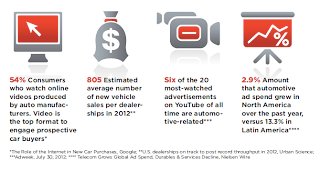
Introduced in March 2010, DEC is already licensed by more than 100 of the Fortune 500 -- including Coca-Cola, Microsoft, Intel, Target, GM, Maybelline and Sony -- who use it to drive content consumption, sharing, conversation, and conversion easily and simultaneously across Web, mobile, and social media touch points, often on a global basis.  In October of 2012, the company released DEC 4, the newest version of its flagship product. [...]
In October of 2012, the company released DEC 4, the newest version of its flagship product. [...]
While Facebook and Twitter are popular platforms, YouTube appears to be the new favorite with automotive brands.
Why YouTube?
Thismoment investigated why car brands, which previously dedicated bulk of their marketing budgets to TV, are now focusing on YouTube. [...]
Valued Customers & Partners, We're pleased to kick off the new year with updates to the Distributed Engagement Channel ("DEC") that enhance analytics and reporting capabilities, give the Content Report a new user-friendly look and feel, and add Google+ integration for greater brand reach.
All of Your YouTube Data in One Place
DEC now offers the industry's deepest analytics integration with YouTube.
It's the first solution to provide a unified view of expanded YouTube Channel Insights alongside key performance metrics from Facebook, Twitter, Google+, LinkedIn and Google Analytics. By consolidating even more data in DEC's Content Report, we enable better visibility and a more efficient workflow. [...]
SAN FRANCISCO, CA--(Marketwire - Jan 23, 2013) - Thismoment, the leading enterprise solution for digital brand experience creation, distribution and management, today announced the industry's deepest analytics integration with YouTube. The new capabilities make Thismoment's flagship product, the Distributed Engagement Channel ("DEC"), the first solution to provide brand marketers with a unified view of expanded YouTube Channel Insights alongside key performance metrics from Facebook, Twitter, Google+, LinkedIn and Google Analytics.
DEC customers already enjoyed the ability to track, filter and report on YouTube Views by distribution point and geography within DEC's Content Report. Now, they may analyze additional YouTube brand channel data including Subscribers Gained, Likes, Comments, Shares and Favorites. [...]

With more than 800 million monthly unique visitors, 4 billion hours of video viewed streamed every month and the number of YouTube-based campaigns growing exponentially, YouTube has become a key marketing channel.
From Super Bowl campaigns like Audi's 2012 "Vampire Party" to promotion for major motion pictures like The Dark Knight Rises to user-generated content, product demos, extensions of TV spots, webinars, serial shorts and other branded media of every shape and size, brands are embracing YouTube. As a result, channel content has diversified and expanded.
According to Robert Kyncl, Global Head of Content at YouTube, the next ten years will see a continued shift in focus from lower-quality user-generated videos and "viral successes” to those that can build "sustained audiences."
Even as YouTube's scale and potential have motivated brands to add it to their social marketing arsenal, the channel has become more crowded.
How do brands stand out?
3 Steps to YouTube SuccessJust a few years ago, marketers addressing YouTube only had to focus on a few factors--namely featuring compelling content and making it "sharable"--to achieve campaign success. Today, the pressure is on for marketers to make their YouTube channels unique, findable and scalable. Let’s look at how to do this.
- Boost Your Search Engine Potential: No matter how good your brand channel is, it's likely to be lost within the multitude of content on YouTube if it isn't visible or "findable". [...]
Facebook has announced a major addition to its social network - a smart search engine it has called "Graph Search". 
The feature allows users to make "natural" searches of content shared by their friends.
Based on the limited information available so far, Graph Search seems to be an innovative take on search and recommendation engines, framing typical search results like restaurants and movies against their relevance in your social graph.
This could allow users to search for "movies liked by Stanford students" or "dentists my friends have visited in the last month". [...]








